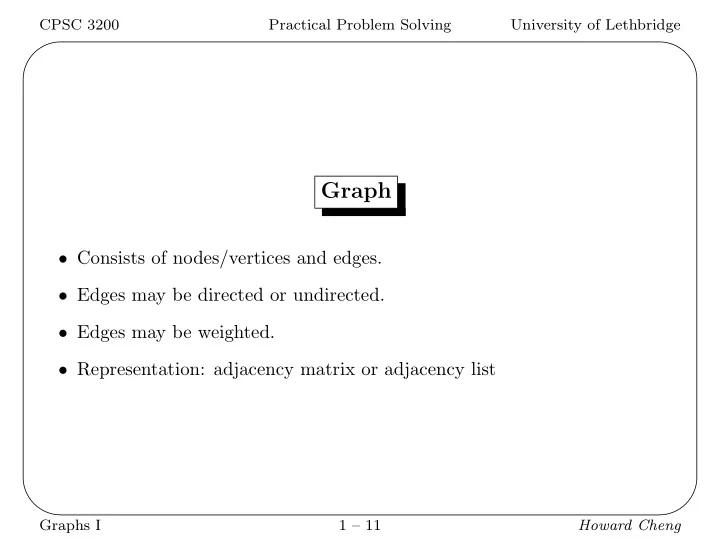

✬ ✩ CPSC 3200 Practical Problem Solving University of Lethbridge Graph • Consists of nodes/vertices and edges. • Edges may be directed or undirected. • Edges may be weighted. • Representation: adjacency matrix or adjacency list ✫ ✪ Graphs I 1 – 11 Howard Cheng
✬ ✩ CPSC 3200 Practical Problem Solving University of Lethbridge Graph • Adjacency matrix – Adjacency determination: O (1) – Finding neighbours: O ( n ) – O ( n 2 ) space • Adjacency list – Adjacency determination: O ( n ) – Finding neighbours: O (deg) – O ( n + m ) space ✫ ✪ Graphs I 2 – 11 Howard Cheng
✬ ✩ CPSC 3200 Practical Problem Solving University of Lethbridge Implicit Graphs • Sometimes the graph is too big to build compared to the portion that is explored. • If there is a way to generate neighbours given any vertex, we do not have to explicitly build the graph. • e.g. configurations of some puzzle or game ✫ ✪ Graphs I 3 – 11 Howard Cheng
✬ ✩ CPSC 3200 Practical Problem Solving University of Lethbridge Depth-first Search • Can be used to process connected components. • Need to watch out for stack overflow. • Relatively simple to write. • O ( n 2 ) or O ( n + m ) depending on representation. ✫ ✪ Graphs I 4 – 11 Howard Cheng
✬ ✩ CPSC 3200 Practical Problem Solving University of Lethbridge Breadth-first Search • Similar to DFS but uses a queue. • Guaranteed to examine closest vertices first (by number of edges). • Can be used to find shortest paths when each edge has same weight. • O ( n 2 ) or O ( n + m ) depending on representation. ✫ ✪ Graphs I 5 – 11 Howard Cheng
✬ ✩ CPSC 3200 Practical Problem Solving University of Lethbridge Bipartite Check • Colours must alternate between black and white. • Use DFS to colour nodes, and make sure that no coloured neighbour has the same colour. ✫ ✪ Graphs I 6 – 11 Howard Cheng
✬ ✩ CPSC 3200 Practical Problem Solving University of Lethbridge Topological Sort • Given a directed acyclic graph, returns an order of the vertices such that if there is a path from v 1 to v 2 then v 1 occurs earlier than v 2 in the order. • e.g. satisfying prerequsite requirements • top_sort.cc in library. ✫ ✪ Graphs I 7 – 11 Howard Cheng
✬ ✩ CPSC 3200 Practical Problem Solving University of Lethbridge Biconnected Component • A graph is biconnected if removing any single vertex from the graph (and all adjacent edges) leaves a graph with a single component. • An articulation point is a vertex such that when it is removed, the remaining graph is disconnected. • A biconnected component is a maximal subgraph that is biconnected. • A bridge is a biconnected component with a single edge. • Application: critical points in networks, converting two-way streets to one-way streets. • Biconnected components can be obtained from DFS. • bicomp.cc in library. ✫ ✪ Graphs I 8 – 11 Howard Cheng
✬ ✩ CPSC 3200 Practical Problem Solving University of Lethbridge Strongly Connected Component • A directed graph is strongly connected if between each pair of vertices u and v , there is a path from u to v and vice versa. • Strongly connected components is a maximal subgraph that is strongly connected. • The SCCs in a graph form a directed acyclic graph. • Obtained from DFS. See scc.cc in library. ✫ ✪ Graphs I 9 – 11 Howard Cheng
✬ ✩ CPSC 3200 Practical Problem Solving University of Lethbridge Minimum Spanning Tree • Given a weighted undirected graph, choose a subset of edges so that the graph is connected and the total weight is minimum. • Kruskal’s algorithm is the easiest (based on union-find). • O ( m log m ) ✫ ✪ Graphs I 10 – 11 Howard Cheng
✬ ✩ CPSC 3200 Practical Problem Solving University of Lethbridge Applications of MST and MST Algorithms • Cheapest way to connect a set of computers, cities, etc. • Minimum spanning forests. • Second-best MST. • Minimax path problems. ✫ ✪ Graphs I 11 – 11 Howard Cheng
Recommend
More recommend